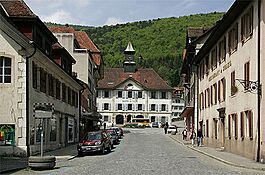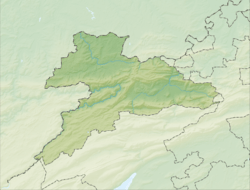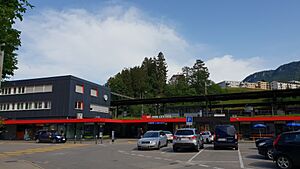Moutier facts for kids
Quick facts for kids
Moutier
|
||
|---|---|---|

The Hôtel de ville (town hall) of Moutier
|
||
|
||
| Country | Switzerland | |
| Canton | Jura | |
| District | Jura bernois | |
| Area | ||
| • Total | 19.61 km2 (7.57 sq mi) | |
| Elevation | 535 m (1,755 ft) | |
| Population
(Dec 2020 )
|
||
| • Total | 7,348 | |
| • Density | 374.71/km2 (970.49/sq mi) | |
| Postal code |
2740
|
|
| Surrounded by | Perrefitte, Champoz, Court, Eschert, Belprahon, Roches, Châtillon, Soulce | |
Moutier is a town in Switzerland. It is currently part of the Jura bernois area in the Canton of Bern.
On March 28, 2021, the people of Moutier voted to leave the Canton of Bern. They want to join the Canton of Jura instead. This change won't happen right away. It involves a long process to transfer responsibilities between the two cantons. Moutier is currently the biggest town in Jura bernois.
Contents
History of Moutier
Moutier was first mentioned in old writings in 1154. Its name comes from the word Monasterii, which means 'monastery' or 'abbey'. The German name for the town is Münster (BE), but it's not used very often.
Early Settlements and the Abbey
The area where Moutier is located was settled even before the Moutier-Grandval Abbey was founded around the year 640. The early history of the town is closely linked to this Abbey.
Between 1049 and 1150, the Abbey received land donations. This helped it become a powerful landowner in the region. The village church of Saint-Pierre was likely built during the early Middle Ages.
In the 12th century, another monastery was started in Moutier. However, it was destroyed in a fire in 1269. The collegiate church of Saint-Germain and Saint-Randoald was also built in Moutier during this time.
The Reformation and Changes
Everything changed in Moutier after the Protestant Reformation was accepted by Bern in 1531. The Abbey closed down. The group of canons (priests) who lived there moved to Delémont.
The church of Saint-Germain and Saint-Randoald was closed. The church of Saint-Pierre became a Protestant church and was made bigger. A fire destroyed the Saint-Germain and Saint-Randoald church in 1571. Later, a new Reformed church was built on its site between 1860 and 1863. The Saint-Pierre church was taken down in 1873. Today, Moutier has both German and French-speaking churches.
French Rule and Joining Bern
After the Abbey closed, its properties in Moutier came under the control of the Prince-Bishop of Basel. The Bishop appointed a special manager called a provost. This provost stayed in Moutier until 1797.
In 1797, the French won a war and Moutier became part of France. It was first in the French department of Mont-Terrible. Three years later, in 1800, it became part of the Haut-Rhin department.
After Napoleon was defeated, Moutier was given to the Canton of Bern in 1815. Two years later, in 1817, the Canton of Bern bought the provost's castle. They used it as the main office for the district governor.
Industrial Growth and Transportation
During the 19th and early 20th centuries, Moutier became an important place for transportation. A railway line opened between Basel and Moutier in 1876. More railway lines followed: to Biel in 1877 and to Solothurn in 1908.
In 1915, the 8.6 km (5.3 mi) long Grenchenberg tunnel connected Moutier and Grenchen. This large network of roads and railways helped Moutier grow into an industrial town. Three industries became famous: glass-making, watchmaking, and automatic lathes.
Glass-Making in Moutier
In 1842, Célestin Châtelain started the Verrerie de Moutier glass factory. It became the most important window glass maker in Switzerland. By the 1970s, it produced 250 tons of glass each month.
The way glass was made changed, and the old factory closed in 1978. However, a new company, Verres Industriels SA, had been created in 1955. They started making glass with the new methods. Today, Verres Industriels employs about 200 people.
Watchmaking in Moutier
Watchmaking began as a small home-based business in the Jura region during the 19th century. In the late 1800s, the Grande Fabrique was built in Moutier. By 1880, it employed about 500 workers.
Many watchmakers opened factories in the town. Léon Lévy & Frères and Louis Schwab were some of the biggest. However, many independent watchmakers went out of business during the Great Depression. Those that survived were often bought by ETA SA in the 1950s.
Automatic Lathes and Tornos SA
In 1883, Nicolas Junker started the Junker & Cie company. They made automatic lathes, which are machines used to shape materials. After some changes, the company became Usines Tornos in 1918.
Tornos grew by buying other companies. At its busiest in 1974, the company employed about 3,000 people. Usines Tornos built homes for workers, provided jobs, and offered training. This helped Moutier grow a lot. In 2010, the company, now called Tornos SA, employed 855 people, with 655 of them in Moutier.
Modern Moutier and Political Debates
Moutier became a city in 1950, and many new buildings followed. A swimming pool opened that year. New schools and a new train station were built. The old secondary school became the town hall in 1962. A new hospital was built in 1976.
Moutier has two museums: the villa Bechler, which houses the Jurassic Museum of Arts, and the villa Junker, which has the Museum of Automatic Lathes.
A big political issue in Moutier is whether it should stay with Bern or join the Canton of Jura. This is called Jura separatism. In 1974, people voted to stay with Bern by only 70 votes. This led to some protests.
More votes happened, and in 1998, the town again voted to stay with Bern by a small number of votes. In 2013, most residents of Moutier wanted to join Jura, but the overall vote in the region was to stay with Bern.
On June 18, 2017, Moutier held another vote. This time, 51.7% of citizens voted to join the Canton of Jura. However, this vote was later declared invalid.
On March 28, 2021, a new vote was held. This time, 54.9% of Moutier voters again chose to leave Bern and join Jura. This vote was declared valid. The process of transferring Moutier to the Canton of Jura has begun and is expected to take about 5 years. Once it's complete, Moutier will likely become part of the Delémont District in Jura.
Geography of Moutier
Moutier covers an area of 19.53 square kilometers (7.54 sq mi). About 29.8% of this land is used for farming. A large part, 55.0%, is covered by forests. Buildings and roads make up 13.9% of the area. Rivers and lakes cover 0.9%, and 0.6% is unproductive land.
The area around Moutier is called the Prévôté. It's a valley with a river called the Birs flowing through it. This area stretches from the Court Gorge to the Moutier Gorge. It also includes some scattered farms on the Montagne de Moutier (Moutier Mountain).
On January 1, 2010, Moutier joined the new administrative district called Arrondissement administratif Jura bernois.
Coat of Arms
The coat of arms for Moutier shows a red shield with a silver monastery on it.
People of Moutier (Demographics)
Moutier has a population of about 7,480 people. As of 2010, about 23.4% of the people living in Moutier are foreign nationals.
Most people in Moutier (about 86.5%) speak French as their main language. German is the second most common language (3.9%), followed by Italian (3.6%).
As of 2008, about 49.0% of the population was male and 51.0% was female. About 36.3% of the people living in Moutier in 2000 were also born there.
In 2011, children and teenagers (0–19 years old) made up 20.1% of the population. Adults (20–64 years old) made up 59.3%, and seniors (over 64 years old) made up 20.6%.
The chart below shows how Moutier's population has changed over time:

Important Heritage Sites
The chapel and cemetery of De Chalière are listed as a very important heritage site in Switzerland. The entire town of Moutier is also part of the Inventory of Swiss Heritage Sites.
Economy and Jobs
Moutier has many factories that make very precise machine tools. These include machines like CNC & CAD/CAM machining centers, made by companies like Tornos Bechler SA and Schaublin Machines SA.
As of 2011, the unemployment rate in Moutier was 2.71%. In 2008, there were 3,916 people working in the town.
- About 46 people worked in farming and forestry.
- About 2,121 people worked in manufacturing and construction.
- About 1,749 people worked in the service industry, which includes things like sales, transport, hotels, and healthcare.
Many people who work in Moutier also live there. In 2000, 2,603 workers (53.9% of all workers) both lived and worked in Moutier. About 13.2% of workers used public transportation to get to work, and 55.9% used a private car.
Religion in Moutier
According to the 2000 census:
- About 47.8% of people were Roman Catholic.
- About 28.6% belonged to the Swiss Reformed Church (Protestant).
- Smaller numbers of people belonged to other Christian churches, or were Muslim or Jewish.
- About 9.95% of residents said they didn't belong to any church.
Transportation
Moutier is a railway hub where three train lines meet:
- The line from Basel to Biel/Bienne.
- The line from Solothurn to Moutier.
- The line from Sonceboz-Sombeval to Moutier.
The Moutier railway station serves both regional and long-distance trains.
Climate
Between 1981 and 2010, Moutier had an average of 136 days of rain or snow each year. It received about 1,118 mm (44 in) of precipitation annually. May was the wettest month, with an average of 112 mm (4.4 in) of rain or snow over 13.5 days. February was the driest month, with about 75 mm (3.0 in) of precipitation over 10.4 days.
Education
In Moutier, about 48.6% of the population has completed non-mandatory upper secondary education. About 14.8% have gone on to higher education, like university.
The Canton of Bern school system includes:
- One year of optional Kindergarten.
- Six years of Primary school.
- Three years of mandatory lower Secondary school, where students are grouped by their abilities.
After lower Secondary, students can continue their education or start an apprenticeship.
During the 2011–12 school year, there were 918 students in Moutier.
- 144 students were in kindergarten.
- 456 students were in primary school.
- 318 students were in lower secondary school.
Many students in Moutier's schools were either permanent residents from other countries or had a different first language than the classroom language.
Moutier has a library called the Bibliothèque régionale. In 2008, it had over 21,000 books and other media. It loaned out more than 50,000 items that year.
Notable People
- John Bost (1817–1881) – A Swiss pastor, musician, and social pioneer.
- Jean-Claude Wicky (1946–2016) – A photographer and filmmaker.
- Jean-Claude Schindelholz (born 1940) – A footballer who played in the 1966 FIFA World Cup.
- Charles Kleiber (born 1942) – A former Swiss state secretary.
- Mauro Poggia (born 1959) – A Swiss-Italian politician and lawyer.
- Romain Crevoisier (born 1965) – A retired Swiss football goalkeeper.
- Sébastien Schneeberger (born 1973) – A Canadian politician who moved from Moutier at age 10.
- Lionel Friedli (born 1975) – A Swiss jazz drummer.
- Cyndie Allemann (born 1986) – A Swiss racing driver.
See also
 In Spanish: Moutier para niños
In Spanish: Moutier para niños













